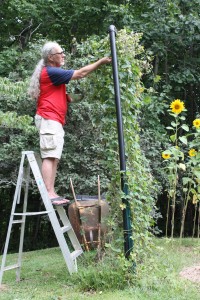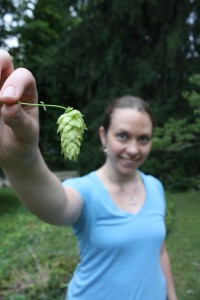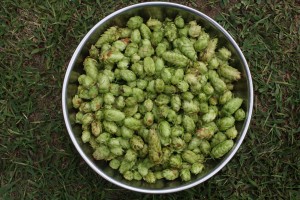“Dad, that ladder is in miserable condition! You can’t stand on that; it won’t work!”
“It should work.” My father said, nonchalantly twisting one broken leg out from behind another. There is no convincing this man of safety sometimes, so I kept my distance and stayed on the same side of the hops arbor as him in case that ladder finally gave way.
My father and I spent part of this Labor Day together harvesting hops off the plants Ben and I planted in my parents’ garden last year. Considering the stress of being transplanted and the the half-assed way in which we watched over them, they weren’t doing all that bad. Aside from a Hindenburg-sized bag worm colony in the upper left corner that somehow everyone missed until just then, things were going well.
I learned earlier that hop vines are sticky and prickly and leave behind long pink welts on the inside of your arms, so I was wearing gloves and delicately snipping off each hop cone with a pair of scissors. My father grabbed at each cone with his hand, tore it off and tossed it in the direction of his bowl, much to the entertainment of our loud audience of stray cats.
These plants had thrived for several years at my in-law’s former home. At this point, we can no longer say with any accuracy exactly what variety each of our five plants is. They start as anonymous little sticks — or rhizomes, to be fancy-pants — that magically grow when you shove them in the ground. My husband is certain that when they were planted they had four different kinds: Cascade, Centennial, Golding, and Perle, which sound suspiciously like stripper names to me.
Thunder rumbled and my dad picked up his pace, ladder squeaking woefully, tossing whole clumps of prickly vine in at once. “Be careful!” I hissed, feeling very much like my second-grade self. And about as short, too. I couldn’t reach most of the cones, dangling a tantalizing inch or two above my outstretched arm. The vines will grow up to 25-foot-tall, if you let them. My father dragged the sorry ladder to the other side of the arbor, but even he had to admit it wasn’t going to work there in the softer earth. He brought out a shorter aluminum ladder, which seemed like maybe even a worse idea, given the weather.
Hops are essential in all beer, but especially so in the stuff I really dig — the IPAs, the pale ales, etc. Without getting too technical, there are two basic kinds of hops: the bittering kind and the aroma hops. Bittering hops are higher in acid and therefore used in the beginning of the boil when brewing beer. Their bitterness is shared but much of their aroma is lost. Aroma hops are lower in acid so are then added at the end of the process for a short period of time to ensure their flavor and aroma stay with the beer. All four varieties that we think we may have are aroma hops.
Our hands smelled delicious. We were picking everything on the vines, not being exactly experts on the plants. The best resource I found on growing hops said to pick the cones when they no longer smelled grassy, but had that hop aroma, and when they were papery to the touch. We soon had two mixing bowls full of them — plus a few caterpillars from the bag worm corner.
We have a food dehydrator in which we hope to dry most of them. You can use these “fresh” dry cones to dry hop a beer, meaning you add them late in the fermentation stage of brewing, usually in a secondary fermenter (after the beer has all its bubbling out of its system). We have considered the idea of wet hopping a batch if we get right on it. This refers to using hops fresh from the vine in the brew. It’s easier to do as small-batch homebrewers, as most bigger craft breweries do not have easy access to enough hops to make enough to sell.
When we finished, the cats having long ago abandoned us and the rain finally beginning to fall, we admired our riches that almost no work had earned us. (Is this what the stock market feels like?) Two bowls of green gold and the promise of summer bottled up to drink on long winter nights. On the way home we stopped to take pictures of a rainbow.




